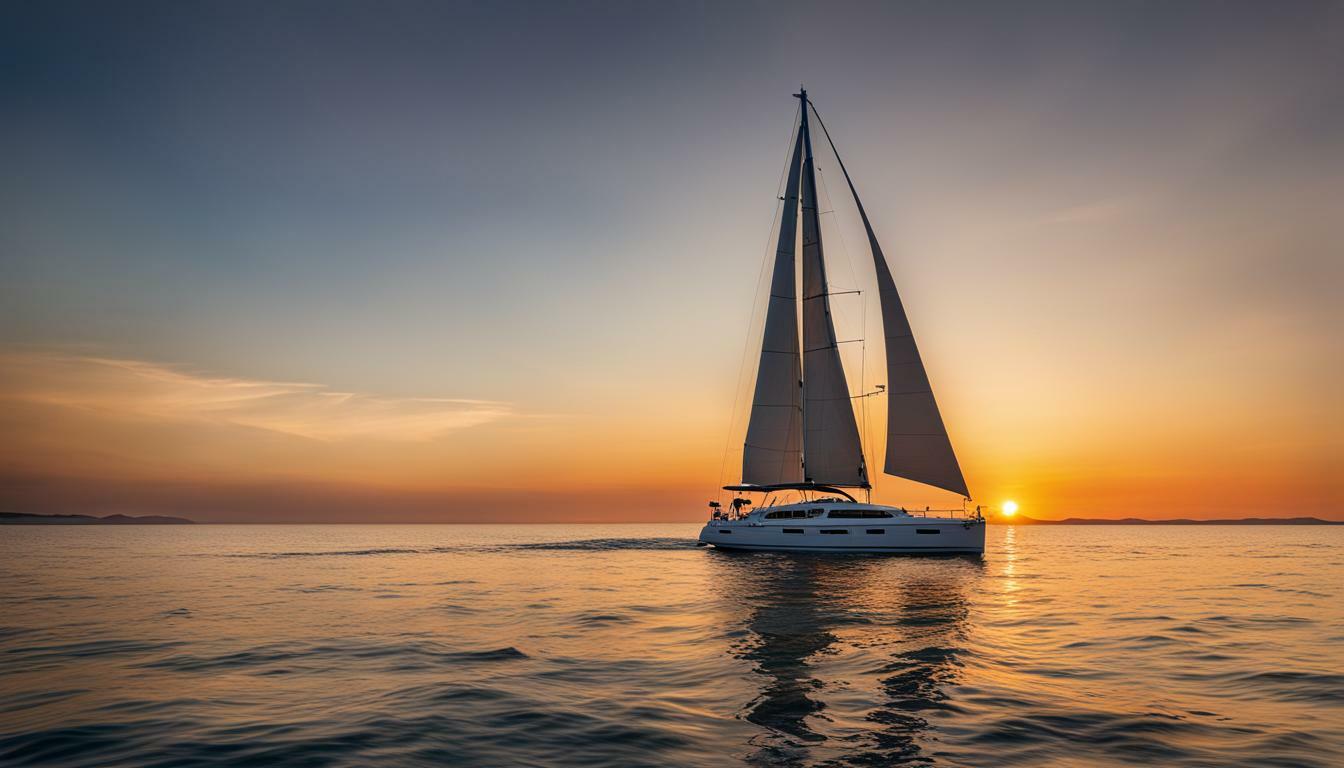When it comes to determining whether a boat can be considered a yacht, size and luxury are the key factors. While there is no official point at which a boat becomes a yacht, generally anything over 40-feet in overall length could be considered a yacht. As the size increases, the boat may be classified as a “mega-yacht” or “superyacht.” However, it’s important to note that length alone is not the sole determining factor. Luxury amenities and features also play a significant role.
The term “yacht” originates from the Dutch word “jaght,” which referred to pleasure boats used by royalty. Therefore, luxury is a defining feature of a yacht. A yacht is more likely to be classified as such if it is large in size and equipped with numerous amenities and entertainment features.
In terms of specific features, Scout Boats offer a range of vessels that could be considered yachts. For example, the 530 LXF boasts a stunning interior cabin with luxury features such as a private master stateroom, hanging closet, and hidden storage. The 420 LXF features a hydraulic beach platform and a Seakeeper Gyro stabilizing system, enhancing comfort and enjoyment. The 380 LXF is another notable model, with a convertible hideaway entertainment system that serves multiple purposes, including bait preparation, grilling, and tackle access. These features place these boats firmly in the category of yachts.
Yacht certification is another important aspect to consider when determining what makes a boat a yacht. Yacht certification involves a thorough evaluation of a yacht’s design, construction, safety features, and overall seaworthiness. Various certification bodies, such as the National Marine Manufacturers Association (NMMA), assess yachts to ensure they meet necessary requirements for safe operation in different waters. The NMMA certification process, for instance, establishes standards that guarantee yachts are safe, reliable, and environmentally compliant.
Key Takeaways:
- A yacht is generally considered to be a boat over 40-feet in overall length, but length alone is not the sole determining factor.
- Luxury amenities and features play a significant role in distinguishing a yacht from a regular boat.
- Specific features found in luxury yachts, such as those offered by Scout Boats, place them firmly in the category of yachts.
- Yacht certification is crucial for ensuring a yacht’s safety, performance, and compliance with necessary standards.
- Various certification bodies, such as the National Marine Manufacturers Association (NMMA), assess yachts to ensure they meet necessary requirements.
Size and Length: The First Step to Yacht Status
While there is no official point at which a boat becomes a yacht, generally anything over 40-feet in overall length could be considered a yacht. As the size increases, the boat may be classified as a “mega-yacht” or “superyacht.” However, it’s important to note that length alone is not the sole determining factor. Luxury amenities and features also play a significant role.
The distinction between a boat and a yacht is not solely based on size and length. A boat over 40 feet may be a yacht, but it requires other distinguishing features to obtain such status. A yacht is expected to have luxury amenities and features to provide lavish enjoyment for its owners and guests. In comparison, boats usually only have the basic necessities.
When it comes to yacht size requirements, the length is not the only factor, and it varies depending on the size of the vessel. While a 45-foot sailing boat may be impressive, it does not meet the same standards as a 45-foot motor yacht. Motor yachts are usually wider and offer more amenities, such as air-conditioned cabins, larger saloons, and a stable platform to host events. Sailing yachts offer a different form of luxury, with extensive sails to harness the power of the wind and provide the ultimate sailing experience.
Size and length are essential factors when classifying boats and yachts. However, the level of comfort, luxury, and design also play a significant role. As a result, manufacturers offer a range of yachts to accommodate different preferences and lifestyles. Some prefer larger vessels with all the latest amenities, while others prefer a smaller, more agile vessel with exceptional handling characteristics.
The Role of Luxury: Taking Yachting to the Next Level
The term “yacht” originates from the Dutch word “jaght,” which referred to pleasure boats used by royalty. Therefore, luxury is a defining feature of a yacht. When it comes to determining whether a boat can be considered a yacht, size and luxury are the key factors. While there is no official point at which a boat becomes a yacht, generally anything over 40-feet in overall length could be considered a yacht. As the size increases, the boat may be classified as a “mega-yacht” or “superyacht.” However, it’s important to note that length alone is not the sole determining factor. Luxury amenities and features also play a significant role.
In terms of specific features, Scout Boats offer a range of vessels that could be considered yachts. For example, the 530 LXF boasts a stunning interior cabin with luxury features such as a private master stateroom, hanging closet, and hidden storage. The 420 LXF features a hydraulic beach platform and a Seakeeper Gyro stabilizing system, enhancing comfort and enjoyment. The 380 LXF is another notable model, with a convertible hideaway entertainment system that serves multiple purposes, including bait preparation, grilling, and tackle access. These features place these boats firmly in the category of yachts.
Yacht certification is another important aspect to consider when determining what makes a boat a yacht. Yacht certification involves a thorough evaluation of yacht’s design, construction, safety features, and overall seaworthiness. Various certification bodies, such as the National Marine Manufacturers Association (NMMA), assess yachts to ensure they meet necessary requirements for safe operation in different waters. The NMMA certification process, for instance, establishes standards that guarantee yachts are safe, reliable, and environmentally compliant.
For yacht owners, certification is often a requirement for operating a vessel in certain waters. Many countries have regulations stipulating that yachts must be certified to be operated within their jurisdiction. Failure to comply with these regulations can result in penalties and fines. Additionally, certification is crucial for insurance purposes. Many insurance companies require a certain level of certification before providing coverage. Certification indicates that a yacht meets safety and performance standards, reducing the risk of accidents or damage. Without certification, obtaining insurance coverage may be challenging or come with higher premiums.
Moreover, yacht certification can positively impact a yacht’s resale value. Potential buyers are more likely to be attracted to a certified yacht, as it implies that the vessel has been well-maintained, safe, and seaworthy. In terms of environmental sustainability, some certification schemes evaluate a yacht’s emissions, noise levels, and other factors that can affect the marine environment. By meeting these standards, yacht owners contribute to a more sustainable yachting industry.
Yacht certification standards vary depending on the certification scheme and the country of registration. Examples of certification schemes include the European Union’s Recreational Craft Directive (RCD), the American Boat and Yacht Council (ABYC) standards, and the International Organization for Standardization (ISO) standards. These schemes assess yachts based on various criteria, such as safety, performance, and environmental impact. Yacht owners should research the applicable certification schemes and ensure their yachts meet all relevant standards and criteria to operate safely and in compliance with regulations.
Notable Yacht Design Elements: Scout Boats and Beyond
In terms of specific features, Scout Boats offer a range of vessels that could be considered yachts. The 530 LXF, for example, boasts a stunning interior cabin with luxury features such as a private master stateroom, hanging closet, and hidden storage. The 420 LXF features a hydraulic beach platform and Seakeeper Gyro stabilizing system, enhancing comfort and enjoyment. Meanwhile, the 380 LXF has a convertible hideaway entertainment system that serves multiple purposes, including bait preparation, grilling, and tackle access. These features place these boats firmly in the category of yachts.
Yacht design elements are not limited to luxury features, however. Yachts also boast unique design elements that contribute to performance and comfort. These design elements include advanced hull shapes, dynamic stabilization systems, and sophisticated navigation and communication equipment. For example, many yachts use wave-piercing hulls that reduce hull resistance and minimize the risk of seasickness. Others use gyroscopic stabilizer systems that reduce yacht roll and increase stability.
Yacht Certification: Ensuring Safety and Quality Standards
Yacht certification is another important aspect to consider when determining what makes a boat a yacht. Yacht certification involves a thorough evaluation of a yacht’s design, construction, safety features, and overall seaworthiness. Various certification bodies, such as the National Marine Manufacturers Association (NMMA), assess yachts to ensure they meet necessary requirements for safe operation in different waters. The NMMA certification process, for instance, establishes standards that guarantee yachts are safe, reliable, and environmentally compliant.
For yacht owners, certification is often a requirement for operating a vessel in certain waters. Many countries have regulations stipulating that yachts must be certified to be operated within their jurisdiction. Failure to comply with these regulations can result in penalties and fines. Additionally, certification is crucial for insurance purposes. Many insurance companies require a certain level of certification before providing coverage. Certification indicates that a yacht meets safety and performance standards, reducing the risk of accidents or damage. Without certification, obtaining insurance coverage may be challenging or come with higher premiums.
Moreover, yacht certification can positively impact a yacht’s resale value. Potential buyers are more likely to be attracted to a certified yacht, as it implies that the vessel has been well-maintained, safe, and seaworthy. In terms of environmental sustainability, some certification schemes evaluate a yacht’s emissions, noise levels, and other factors that can affect the marine environment. By meeting these standards, yacht owners contribute to a more sustainable yachting industry.
Yacht certification standards vary depending on the certification scheme and the country of registration. Examples of certification schemes include the European Union’s Recreational Craft Directive (RCD), the American Boat and Yacht Council (ABYC) standards, and the International Organization for Standardization (ISO) standards. These schemes assess yachts based on various criteria, such as safety, performance, and environmental impact. Yacht owners should research the applicable certification schemes and ensure their yachts meet all relevant standards and criteria to operate safely and in compliance with regulations.
Yacht Certification: Ensuring Safety and Quality Standards
The Importance of Yacht Certification
For yacht owners, certification is often a requirement for operating a vessel in certain waters. Yacht certification involves a thorough evaluation of a yacht’s design, construction, safety features, and overall seaworthiness. This process ensures that a yacht meets the necessary standards for safe operation in different waters. Various certification bodies, such as the National Marine Manufacturers Association (NMMA), assess yachts to establish standards that ensure they are safe, reliable, and environmentally compliant.
Yacht certification is not only a legal requirement but also beneficial for insurance purposes. Many insurance companies demand a certain level of certification before providing coverage. Certification indicates that a yacht meets safety and performance standards, minimizing the risk of accidents or damage. Without certification, obtaining insurance coverage may be challenging or come with higher premiums.
Moreover, yacht certification can have a positive impact on a yacht’s resale value. Potential buyers are more likely to be attracted to a certified yacht, as it implies that the vessel has been well-maintained, safe, and seaworthy. Yacht certification schemes evaluate many aspects of a yacht, including its emissions, noise levels, and other factors that can affect the marine environment. By meeting these standards, yacht owners contribute to a more sustainable yachting industry.
Yacht certification standards vary depending on the certification scheme and the country of registration. Examples of certification schemes include the European Union’s Recreational Craft Directive (RCD), the American Boat and Yacht Council (ABYC) standards, and the International Organization for Standardization (ISO) standards. These schemes assess yachts based on various criteria, such as safety, performance, and environmental impact. Yacht owners should research the applicable certification schemes and ensure their yachts meet all relevant standards and criteria to operate safely and in compliance with regulations.
Resale Value and Market Appeal: The Impact of Yacht Certification
Moreover, yacht certification can positively impact a yacht’s resale value. When a yacht is certified, potential buyers perceive it as a safer, more reliable, and better-maintained vessel. Certification implies that the yacht meets safety and performance standards, reducing the risk of accidents and damage. Buyers are, therefore, more likely to be attracted to a certified yacht. This positive market appeal can increase the resale value of a yacht, making certification a worthwhile investment for yacht owners.
For yacht owners, yacht certification ensures compliance with regulations. Most countries have regulations stipulating that yachts must be certified to be operated within their jurisdiction. Operating an uncertified yacht can result in penalties and fines. Yacht certification is also crucial for insurance purposes. Many insurance companies require a certain level of certification before providing coverage. Without certification, obtaining insurance coverage may be challenging or come with higher premiums.
Luxury yacht criteria and yacht certification also contribute to environmental sustainability. Yacht certification schemes evaluate emissions, noise levels, and other factors that can affect the marine environment. By adhering to these standards, yacht owners can minimise their environmental impact, contributing to a more sustainable yachting industry.
Environmental Sustainability: Yacht Certification and the Marine Environment
In terms of environmental sustainability, some certification schemes evaluate a yacht’s emissions, noise levels, and other factors that can affect the marine environment. The aim is to ensure that yachts operate within environmentally friendly parameters.
The International Organization for Standardization (ISO) has developed the ISO 14001 standard, which provides a framework for assessing and improving environmental performance. The standard covers areas such as energy efficiency, waste management, and pollution control. Yacht owners can use this standard to evaluate their environmental impact and take steps to reduce it.
In addition, the Recreational Craft Directive (RCD) of the European Union includes regulations to reduce emissions from recreational boats. The RCD specifies limits for carbon monoxide, nitrogen oxides, and hydrocarbons, which are harmful pollutants that can affect air and water quality.
Yacht owners can also take steps to reduce the environmental impact of their vessels, such as using eco-friendly cleaning products, reducing fuel consumption, and minimizing waste. By doing so, they contribute to the sustainability of the yachting industry and help protect the marine environment for future generations.
Conclusion
In conclusion, while there is no precise definition of when a boat becomes a yacht, size and luxury are essential factors to consider. Generally, a boat over 40-feet in length can be classified as a yacht, with larger vessels falling into the categories of “mega-yachts” or “superyachts.” Luxury amenities and features further distinguish a boat as a yacht. Yacht certification is also crucial, ensuring a yacht’s safety, performance, and compliance with necessary standards. Certification is required for operating a yacht in specific waters, is important for insurance coverage and resale value, and promotes environmental sustainability. Understanding these factors helps unravel the mystery of what makes a boat a yacht.
FAQ
Q: What size does a boat need to be to be considered a yacht?
A: Generally, anything over 40-feet in length could be considered a yacht.
Q: What role does luxury play in defining a yacht?
A: Luxury is a defining feature of a yacht, with large size and numerous amenities and entertainment features contributing to its classification.
Q: What are some notable yacht design elements?
A: Scout Boats offer luxury yachts with features such as private staterooms, hidden storage, hydraulic beach platforms, and Seakeeper Gyro stabilizing systems.
Q: Why is yacht certification important?
A: Yacht certification ensures a yacht’s design, construction, safety features, and overall seaworthiness meet necessary standards and regulations.
Q: Why is yacht certification important for insurance purposes?
A: Many insurance companies require yacht certification to provide coverage, as it indicates that the yacht meets safety and performance standards.
Q: How does yacht certification impact resale value?
A: Yacht certification positively impacts resale value, as potential buyers are more attracted to certified yachts due to their perceived safety and seaworthiness.
Q: How does yacht certification promote environmental sustainability?
A: Yacht certification schemes evaluate factors such as emissions and noise levels to ensure yachts adhere to environmentally friendly practices, contributing to a more sustainable yachting industry.


